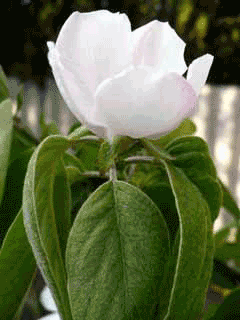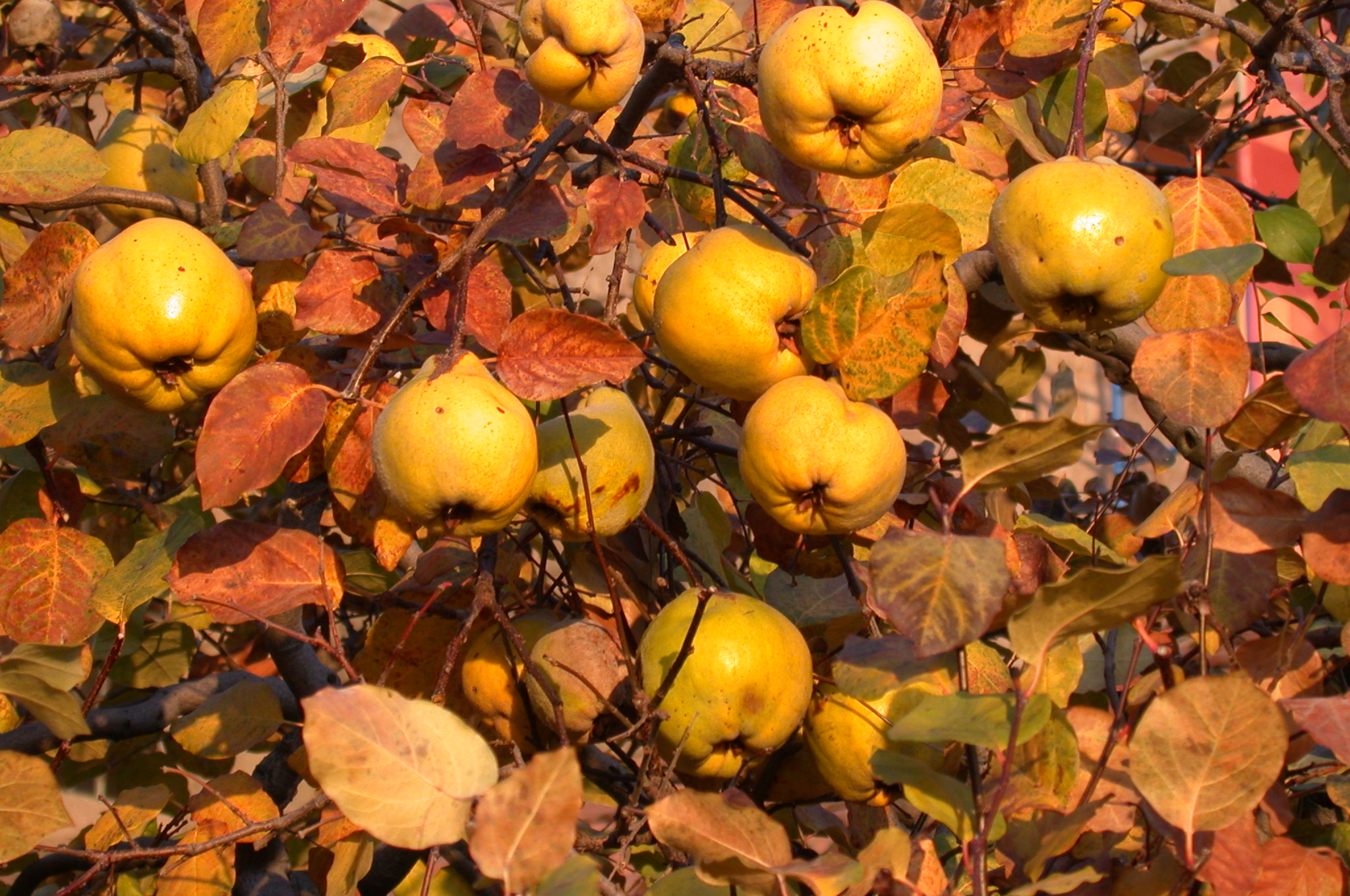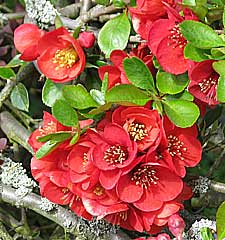Deleted
Deleted Member
Posts: 0
|
Post by Deleted on Nov 12, 2012 14:55:32 GMT -5
I once had a tree. I know the fruit produces many seedlings when planted, and I hope to find a fruit, in the store, this season.
I am wondering what causes the hard nodules to form inside of the fruits.
Is there a straightforward way to prevent this from happening, or can they be easily removed in the cooking process. They're very tough on my juicer.
Also, do the showier, flowering versions produce good fruit.
|
|
|
|
Post by castanea on Nov 12, 2012 20:10:27 GMT -5
I have one quince tree but have never noticed any hard nodules. What are they?
|
|
|
|
Post by steev on Nov 12, 2012 20:38:58 GMT -5
The flowering quince fruit is used in making a lemony syrup or jam.
|
|
Deleted
Deleted Member
Posts: 0
|
Post by Deleted on Nov 13, 2012 17:38:01 GMT -5
 Thanks for answering. I have one quince tree but have never noticed any hard nodules. What are they? They are hard, about the size of a pea, and the same color as the fruit. Also reported in pears. I'm still learning but will share as I figure it out. The flowering quince fruit is used in making a lemony syrup or jam. the ornamental one?
|
|
|
|
Post by khoomeizhi on Nov 13, 2012 21:38:41 GMT -5
stone cells (sclereids) . pretty common in pears and quinces (some varieties more than others)...lots of info out there once you know the name!
ornamental/flowering quinces sure don't make fruit that competes with the good big fruiting varieties, but they're good for what they are. (basically temperate lemons)
|
|
Deleted
Deleted Member
Posts: 0
|
Post by Deleted on Nov 14, 2012 12:13:12 GMT -5
Thanks for the reference. I have now taken a little time to learn about it. Though the mechanism is not fully understood, it is perhaps associated with wound repair. I question whether this might be averted with organic pest controls or growing conditions which would tend to prevent splitting. I would like to play with ornamental quince for the looks of it, and for the grafting stock, but consider the more-edible version to be a beautiful plant, with it' s larger leaves and flowers and somewhat knobby growth habit. In the larger-fruiting version I tasted notes of pineapple and pear. I will keep a lookout for both. Cydonia oblonga -- edible quince (pfaf.org)  Cydonia oblonga -- edible quince (metmuseum.org, Medieval Garden)  Chaenomeles japonica -- flowering quince (garden-grower.com)  Loved your websites. In my experience, the edible quince are nearly as hard as green wood, before cooking. I felt this fruit has character but is labor intensive. The most effective way I had to deal with it was to force the resulting mash through a colander. Some Mexicans retain Old World imports like these in rancho markets. The paste is gelled in molds, shaped like pie-pans. Half of one costs about $5. Sweet empenadas (small stuffed pies) are stuffed with this filling, and American pie makers apparently used chopped quince, to give the appearance of apples, under the heavy cooking of mass production lines. |
|
Deleted
Deleted Member
Posts: 0
|
Post by Deleted on Nov 23, 2012 20:08:39 GMT -5
Have Esme quince seeds coming, will eventually share suckers.
|
|
Deleted
Deleted Member
Posts: 0
|
Post by Deleted on Nov 26, 2012 13:31:58 GMT -5
On how to process this tough fruit --
Some are even named after iron!
Some are sweeter, developed to be eaten out-of-hand.
But, they were traditionally harvested after a freeze.
I consider what a freeze does to my tomatoes, still on the vine. They seem to lose some acidity, and start to break down, inside.
This is considered the ideal treatment for a sour and almost-woody fruit.
|
|
|
|
Post by MikeH on Nov 26, 2012 18:03:11 GMT -5
|
|
|
|
Post by steev on Nov 26, 2012 20:45:06 GMT -5
Doubtless I've mentioned this before: when I was a kid, everyone had a quince in the backyard for two reasons: it was a source of pectin for jelly, and it was a fruit one could have in the Winter (before we could get everything from the other hemisphere or climate-controlled storage). There are both astringent and non-astringent varieties.
I mainly peel, slice off the core, add a bit of water and sugar, cinnamon (preferably stick), and cook covered until tender. That's a tasty and venerable dish, of a uniquely grainy texture and rosy color.
Since it grows well on my farm, I'm slowly expanding my repertoire, from non-astringent (Pineapple) for fresh eating, to Kuganskaya (good as a vegetable in stews). Although my plants are currently multi-stemmed shrubs, quince can be trained to small-tree form, which is my plan (it will be easier to see the crop).
Quince are easy to propagate from hard cuttings; I wonder if anyone has made a product like hard cider or perry from quince; might go better with Manchego cheese than sweet membrillo paste.
|
|
|
|
Post by MikeH on Nov 27, 2012 5:05:10 GMT -5
|
|
|
|
Post by khoomeizhi on Nov 27, 2012 5:25:07 GMT -5
I wonder if anyone has made a product like hard cider or perry from quince; might go better with Manchego cheese than sweet membrillo paste. the closest i've come is quince mead, which was pretty good for what it was. like you'd expect, it was super-fragrant and fairly sour. |
|
Deleted
Deleted Member
Posts: 0
|
Post by Deleted on Nov 27, 2012 16:24:08 GMT -5
I'm reading that some kind of brandy is traditional, where they're grown. Different kinds of schnapps, comparable to ouzo, are apparently traded like aqua vitae.
|
|
|
|
Post by steev on Nov 27, 2012 21:42:13 GMT -5
Well, there you go; humans are so inventive in the pursuit of getting loaded.
|
|
|
|
Post by mountaindweller on Nov 28, 2012 2:47:39 GMT -5
Quinces make the best jelly ever (you must produce the juice first). Then you can bake them like apples in the oven with a bit of nuts, raisins cinammon honey in the middle (or whatever you are fancy). My grandfather always put some quinces in the hard cider but don't ask me how much (I was far too small for hard cider). They can be used as well in your Sunday rost (not too much). Traditionally they are made into a fruit leather. You cannot replace quinces for apples though, in a tart they stay hard.
|
|